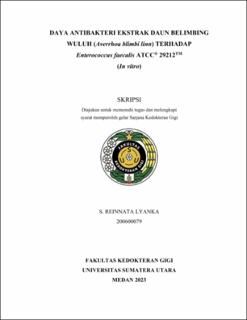| dc.description.abstract | Enterococcus faecalis is the bacteria that most often found in failed root canal
treatment. The medicinal plant bilimbi (Averrhoa blimbi linn) has antibacterial
substances in the form of flavonoids, tannins, saponins and alkaloids. The aim of the
research was to determine the inhibition zone, Minimum Inhibitory Concentration
(MIC) and Minimum Bactericidal Concentration (MBC) of bilimbi leaf extract against
Enterococcus faecalis ATCC®29212™ concentrations of 60%, 40%, 20% and 10%.
The method used was laboratory experimental with a post test only control group
design. Determination of the inhibition zone using the standard Kirby Bauer blank disk
diffusion method measured with digital slide calipers, while the MIC and MBC dilution
methods were used to determine the level of turbidity and clarity. Bilimbi leaves were
extracted using the maceration method, grouped into 4 treatments and 4 replications.
Data analysis used the Oneway Anova test, followed by the Post Hoc Least
Significance Difference (LSD) test to determine significant differences in each
concentration. The research results showed that the average diameter of the inhibition
zone at concentrations of 60%, 40%, 20% and 10% was 14,56 mm, 12,75 mm, 10,93
mm, dan 9,81 mm. MIC at a concentration of 20 % and MBC at a concentration of
60%. The conclusion is that there is significant antibacterial power from bilimbi leaf
extract against the growth of Enterococcus faecalis ATCC®29212™ with a
significance value (p=0.000), the strongest inhibitory zone diameter at a concentration
of 60% with an average diameter of 14.56 mm, if the concentration increases then the
antibacterial power of the extract will increase | en_US |





